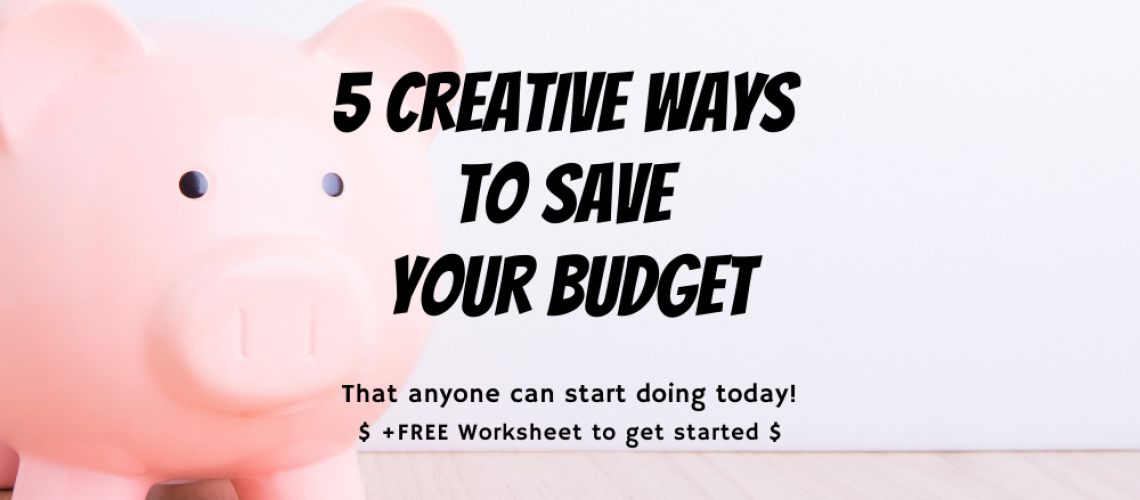
Do you have a budget? It is estimated 30-50% of Americans do not. You do not have to be an accountant to create or manage your own budget.
We can get you started right in this post by downloading the Starter Sheet above. Knowing where your money is going can go a long way in designing the life you want. Let’s learn how a budget can help us and I’ll give you my top 5 creative ways to save money.
What Can a Budget Do?
Having a budget is not only beneficial to help manage expenses but also to help to save money or know what money you have to spend on discretionary items like hobbies, clothes, or whatever your retail therapy may be. It’s so easy to spend money on the wrong things…things that are unnecessary or are convenient, but not meaningful to your life.
Having a budget can also help in the longterm with seasons of life including retirement, investments, unforeseen expenses, and childcare if you have kids (think summer camp and babysitting expenses).
Does any of this bring about anxiety?
Don’t worry! Starting a budget is a lot easier to start than you think and with many applications today to help you manage it, it’s pretty darn easy.
What Type of Budgeter Are You?
There are 2 types of budgeters…
Ruler: A Budget Ruler is someone who creates rules to follow with a budget. For example, they may break down their budget into different categories with a spend amount they would meet or stay under a particular threshold. They may set fixed amounts for spending such as if I want something not in budget I’ll give myself $100 a month to spend.
Flexer: A Budget Flexer doesn’t break down their budget as tight as a Ruler. They may look at their income and know how much they have going in and out. Sometimes Flexers will have “budget envelopes” where they have loose categories they follow, but they keep it open and move money around depending on the month.
Which one are you? Maybe you’re a little bit of both and that’s ok…whatever works!

Top 5 Creative Ways to Save:
- Knowing what you already have: This is #1 because it happens more often than not. Think grocery shopping where you may buy something thinking you are out of it, but because you didn’t check you bought it again. Or back to school shopping where you get new pencils every year when you already have 25 pencils sitting somewhere. Get organized at home so you know what you have. Check out this post here for organizational tips.
- Pay yourself first: Set up automatic withdrawals to go to your savings, investment, or other accounts first before it gets spent on other things. This guarantees you are saving something and I would recommend that saving is in some sort of account that can gain your interest along the way like a money market account.
- Window shop: Buying things online is so easy with one-click options, ads that only show what you are interested in, and saved credit cards on apps. I recommend window shopping first, so add things to your online cart. Then later on in the day go back and ask yourself if you really need them. If you didn’t buy, where would you put that money instead? Perhaps towards something bigger like a vacation or a new car? Frivolous spending can add up fast.
- Save gifts and taxes: Most people think cash and tax refunds are “free money” to spend. Money is money and what you do with it matters. Next time you get a gift, put it in the bank or invest it. That $20 in an interest bearing savings account could turn into almost $30 with a year in the bank…$100 could be $142…and it only goes up from there. Also, a tax refund is not free money, it’s money you overpaid out of your paycheck. If you get large refunds every year, it probably means you need to adjust your paychecks so less tax is taken out, which would give you a higher paycheck.
Budget Tools:
If you are not a numbers person, pretty colors and graphs can give a great visual that make numbers easier to understand. Here are some apps that can get you started.
Mint: Free, can link your bank accounts and create different budget categories. Creates cool graphs to see where you spend and gives you a total for what you have left as the month goes.
YNAB: Not free, but you can try for a month to see if you like it.
Qapital: Also not free, but plans are as low as $3 a month. Help manage everyday financing and create maintain separate accounts for a savings goal.
So go out there and conquer that hard-earned money! You worked for it, so make it work for you and design the life you want by managing your budget one day at a time.



